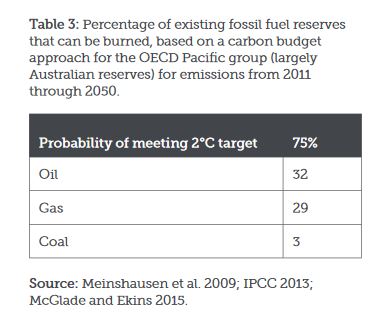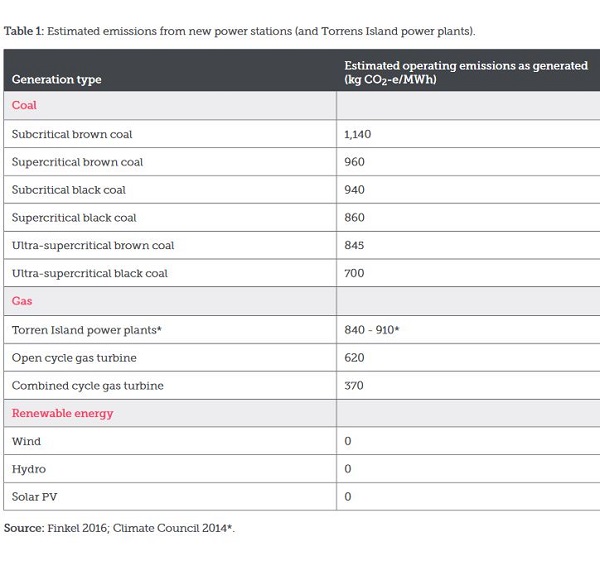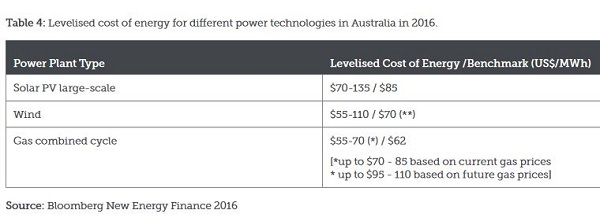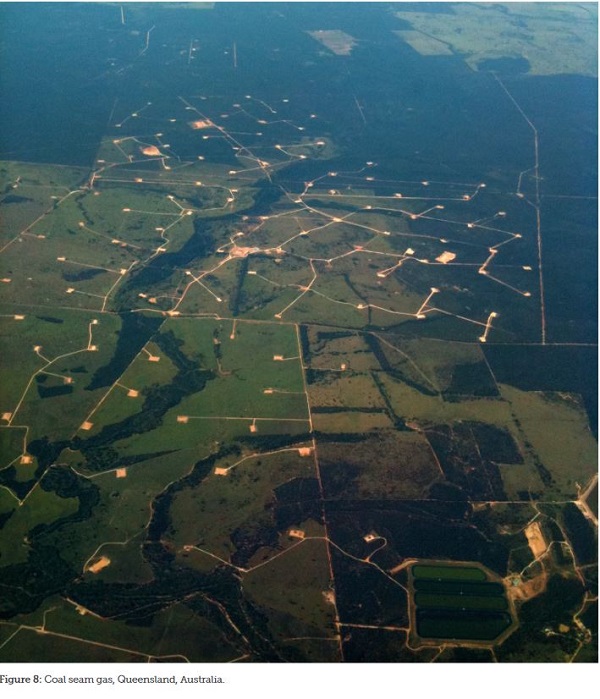 The Climate Council issued a report on the future of gas-fired electricity just after Easter – Pollution and Price: The Cost of Investing in Gas.
The Climate Council issued a report on the future of gas-fired electricity just after Easter – Pollution and Price: The Cost of Investing in Gas.
Gas is often thought of as a ‘transition fuel’ from coal to renewables. Their advice is clear:
- Do not provide policy support for new gas power plants or gas supply infrastructure.
And:
- Existing gas plants should be thought of as a short-term, expensive, emergency backup as renewable energy and storage is rapidly scaled up.
Moreover, we should leave most of our gas reserves in the ground.
They believe we should phase out of fossil-fuelled electricity generation over the next 2-3 decades.
They would also envisage a more distributed electricity generation system, along with greater connectivity in the grid.
Australia has entered into serious commitments under the Paris Agreement:
- Under the Paris Agreement, world leaders including Australia agreed to limit global temperature rise to well below 2°C above pre-industrial levels, and to pursue efforts to limit temperature rise to only 1.5°C. This near universal agreement – signed by 196 nations, ratified by 139 nations and accounting for 97% of global emissions – entered into force on 4 November 2016. Australia ratified the Paris Agreement on 9 November 2016 (UNFCCC 2017).
In the lead up to the Paris talks the Climate Change Authority recommended that Australia should reduce its emissions 40 – 60% below 2000 levels by 2030 (or a range of approximately 45-65% below 2005 levels) as our contribution for a two-thirds chance of avoiding 2°C warming.
Greater reductions are obviously needed to contain warming to 1.5°C and to achieve better odds.
Burning fossil fuels accounts for 90% of emissions, they say (seems high to me). Using the carbon budget approach, they give this table of burnable carbon reserves:

For more information, see the Council’s report Unburnable Carbon: Why we need to leave fossil fuels in the ground.
Electricity generation accounts for 35% of our emissions, having increased by 46% from 1990 to 2016. Now:
- Australia’s electricity generation is dominated by high emissions fossil fuels (black coal 43%, brown coal 20%, gas 21% and oil 3%) with renewable energy making up 14%.
This table shows emissions intensity by power source:

Apparently gas for peaking power needs to be open cycle, so the critical numbers are 620 as against 700 for ultra-supercritical black coal.
We are told that some existing gas plants are as dirty as supercritical black coal. Also there is a problem with fugitive emissions in gas production. We have no idea how much methane is escaping, because it is not measured. We simply adopt the American official figures.
Studies have shown that coal seam gas in the USA leaks 1.8 to 3.5 times as much as the official figures would have us believe. The report says:
- If gas power is to have a net climate benefit compared to coal power, methane emissions must be less than 3 to 4% of production (Alvarez et al 2012; Hardisty et al 2012; NAS 2012). When methane emissions from the gas supply chain reach these levels and are added to the carbon dioxide emissions generated from burning gas in a power plant, the greenhouse gas pollution associated with generating electricity from gas is similar to coal. (Emphasis added)
Reports from the US indicate that their unconventional gas leaks 2 to 17%.
Much of the infrastructure for gas was built in the 1970s. There is an issue of major incidents, such as the Longford Gas Plant explosion in 1998 which is estimated to have had an economic cost to Victoria of $1.3 billion, and the Varanus Island Explosion in 2008 which cost the WA economy an estimated $2.4 billion. Then there was the major Montara Wellhead Platform incident in 2009, where oil and an unknown amount of gas was released before the platform eventually caught fire and burned after 70 days when a well control barrier failed.
The rest of the reports goes into detail as to how an electricity system based on renewables is technically feasible and affordable. They give this table of comparative electricity costs:

The double asterisk points out that some recent Australian wind contract prices are reportedly as low as US$55/MWh (AFR 2017b).
The single asterisk tells us that current actual Australian gas costs would increase benchmark combined cycle power costs to around US$75-80/MWh, while costs projected by Energyquest (Energyquest 2017) for 2024 of A$14/GJ (US$11/GJ) would increase benchmark combined cycle costs to around US$100/MWh.
The report contains quite a lot of detail about the gas industry, and why it is unrealistic to expect new sources of gas to be found in eastern Australia other than coal seam gas, and remind us why CSG has effectively lost its social licence. Here’s what it looks like just after installation:

They also cover what has happened recently in extreme weather, pointing to the vulnerability of the network, and the failure of a number of gas-powered facilities under the stress of heat, for example in NSW where 3,000MW of gas and coal-fired plant wasn’t available.
My main criticism would be that they don’t address the cost of storage in any detail, nor the cost of grid upgrade. Nevertheless it is becoming clear that new gas is not an option, and old gas should start to disappear. Bankers and financiers are likely to learn faster than politicians in the major parties.
In breaking news, Turnbull is intervening in the gas market, promising cheaper gas.
And a group within the Labor Party are looking at getting out of coal mining.

If we are talking about back up power, that will only be used for a small amount of time, both emission figures and running cost are not important. The key questions are:
How long can it provide power?
Start-up time?
Source and, where relevant, storage of fuel.
Capital cost.
John, it seems to me that back-up power has to be a specialised function, kept in reserve and paid for by the whole system.
Mathematical modelling should be able to tell us how much and where best to locate it.
Inherently batteries and pumped storage are more rapidly dispatchable than gas.
Apart from sustainable sources and power back up, better management of energy consumption has to be the third major component of future energy systems. Dumb on-off switches and tariff systems should be a dispatched into history soon.
Ootz: You are right, Contracting someone to provide load dropping capacity may be a lot more cost effective than having standby power or storage.
Brian: Not all back-up has to be quick response. Some of the back-up does not have to be quick response. For example, when we know we are likely to have a heatwave a coal or gas fired power station can be cranked up. This either requires government owned systems or contracts to supply back-up. Keep in mind though fuel supply and storage issues.
Me I like solar thermal with back-up heating to reduce the need for back-up but keep in mind that the characteristics of this type of system would be similar to coal fired without the emissions.
John, the main thing I have in mind is that we should shed gas as soon as we can. As to what’s best for the grid, I’m heartened by the way the new boss of AEMO, Audrey Zibelman who was head-hunted from New York, is talking. She seems to have her head around the issues.
Ootz, last week I visited the local Telstra shop, just to replace the 3G mobile phone I accidentally consigned to the tip with green waste from giving the tall hedge a haircut.
The salesman told me about the new deal they have that turns your home into an electronic paradise, so you can turn on the jug from the bedroom when you wake up, and check who has been coming in and out of the front door when you are on holidays and have left the kids in charge.
For a fee, of course.
Brian: I think we have to proceed towards something close to 100% as fast as we can but this does not necessarily mean that we should “get rid of gas as fast as we can”. We may (or may not) actually progress in a more cost effective way by putting most of our money into increasing renewable capacity, delaying some battery installations and staying with fossil peak power at this stage of the process. For storage and flexibility reasons I would think liquid fuel may make a lot more sense that gas. (Our back-up gas turbines at Newman ran on bunker fuel.)
John when I say we should “get rid of gas as fast as we can”, I don’t mean mindlessly. I mean being rational about it, but recognisisng that it isn’t a ‘clean’ fuel and is almost certainly dirtier than most people, including policy makers and perhaps some scientists, think.